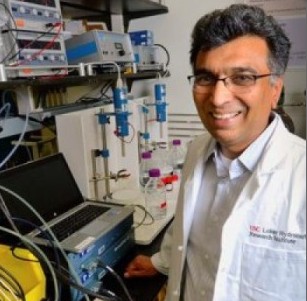Jun
26
New Redox Battery For the Power Grid
June 26, 2014 | 2 Comments
University of Southern California (USC) scientists have developed a rechargeable battery that is all organic and could be scaled up easily for use in power plants. The battery could make the energy grid more resilient and efficient by creating a large-scale means to store energy for use as needed. This level of battery sophistication could enable renewable energy sources to make up a greater share of the nation’s energy generation.
Sri Narayan, professor of chemistry at the USC Dornsife College of Letters, Arts and Sciences said, “The batteries last for about 5,000 recharge cycles, giving them an estimated 15-year lifespan. Lithium ion batteries degrade after around 1,000 cycles, and cost 10 times more to manufacture.”
Narayan is the corresponding author of a paper describing the new batteries that was published online by the Journal of the Electrochemical Society.
The new battery is based on a redox flow design, similar in design to a fuel cell, with two tanks of electroactive materials dissolved in water. The solutions are pumped into a cell containing a membrane between the two fluids with electrodes on either side, releasing energy.
The design has the advantage of decoupling power from energy. The tanks of electroactive materials can be made as large as needed – increasing total amount of energy the system can store – or the central cell can be tweaked to release that energy faster or slower, altering the amount of power (energy released over time) that the system can generate.
Narayan collaborated with Surya Prakash, Prakash, professor of chemistry and director of the USC Loker Hydrocarbon Research Institute, as well as USC’s Bo Yang, Lena Hoober-Burkhardt, and Fang Wang.
Prakash said, “Such organic flow batteries will be game-changers for grid electrical energy storage in terms of simplicity, cost, reliability and sustainability.” This is a couple of optimistic guys. Five thousand cycles is quite an accomplishment and very suggestive of the potential.
The team’s breakthrough centered around the electroactive materials. While previous battery designs have used metals or toxic chemicals, Narayan and Prakash wanted to find an organic compound that could be dissolved in water. Such a system would create a minimal impact on the environment, and would likely be cheap, they figured.
Through a combination of molecule design and trial-and-error, they found that certain naturally occurring quinones – oxidized organic compounds – fit the bill. Quinones are found in plants, fungi, bacteria, and some animals, and are involved in photosynthesis and cellular respiration.
“These are the types of molecules that nature uses for energy transfer,” Narayan said.
Currently, the quinones needed for the batteries are manufactured from naturally occurring hydrocarbons. In the future, the potential exists to derive them from carbon dioxide, Narayan said.
The batteries could make renewable energy sources production of a greater share of the nation’s energy generation more practical. Solar panels can only generate power when the sun’s shining, and wind turbines can only generate power when the wind blows. That inherent unreliability makes it difficult for power companies to rely on them to meet customer demand.
With batteries to store surplus energy and then release it out as needed, intermittency could cease to be such an important and costly issue.
For power grid use sheer scale is vastly more important that say an electric vehicle or a lap top computer. The cost per watt has to be very low indeed.
Narayan said, “‘Mega-scale’ energy storage is a critical problem in the future of the renewable energy, requiring inexpensive and eco-friendly solutions.”
The team has filed several patents in regards to design of the battery, and next plans to build a larger scale version.
This might be the technological tipping point for intermittent power sources. But its got to be cheap. Five thousand cycles is really going to help. This is a tech to watch.
Comments
2 Comments so far



We have been waiting for a battery breakthrough and this could be it! I
t does not sound like it is a viable transportation battery – but would be a key step in using batteries for load balancing for the electrical grid. And, doing it all without expensive and toxic heavy metals is a real plus.
It would be a key step in using batteries for load balancing for the electrical grid.